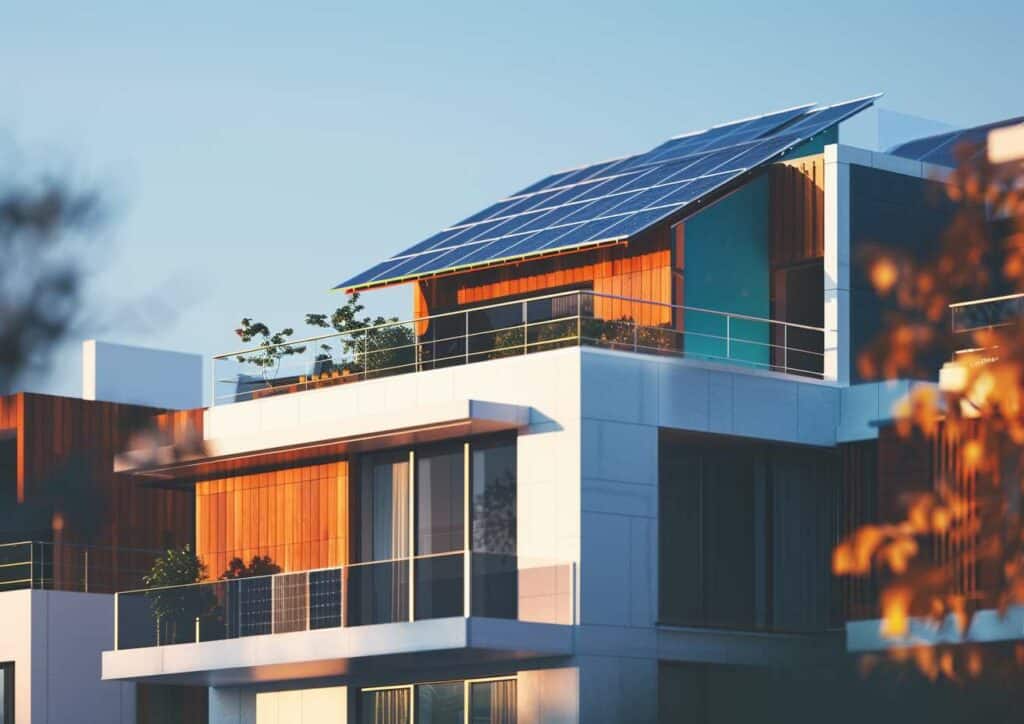Solar power’s rise in popularity as a clean and renewable energy source is reflected in the significant growth of its capacity worldwide. As of 2022, the worldwide manufacturing capacity for solar PV expanded by more than 70%, achieving 450 GW for polysilicon and reaching up to 640 GW for modules. This exponential growth underscores solar power’s pivotal role in the global transition towards more sustainable energy systems.
Installing solar panels on your roof allows you to generate solar electricity from sunlight and significantly reduce reliance on traditional fossil fuel-based power. This helps the environment and leads to long-term savings on your utility bills.
By understanding these elements and making informed decisions, you can optimize your solar panel system’s performance. Whether you live in a sunny area or are intensely interested in renewable energy, this guide will offer practical steps and insights. We’ll explore essential considerations, such as solar panel efficiency, understanding your energy consumption, available incentives, and estimating potential savings.
Understanding Solar Power
Solar panels, also known as photovoltaic (PV) panels, harness the power of the sun to generate electricity. These panels are made up of small units called solar cells, typically composed of silicon. These cells have special properties that convert sunlight into usable electricity through the photovoltaic effect.
When sunlight falls on a solar panel, the solar cells absorb the energy from the photons, which are light particles. This energy excites the electrons within the solar cells, causing them to move and create an electric current. This flow of electrons forms the basis of the electrical energy that can power your home.
By installing solar panels on your rooftop or in open areas with direct sunlight, you can generate clean and renewable electricity to meet your energy needs. This reduces your reliance on conventional electricity sources, often contributing to carbon emissions and environmental degradation.
Furthermore, solar power reduces our dependence on finite resources like coal, oil, and natural gas, which are depleted over time. Unlike fossil fuels, sunlight is an abundant and freely available resource. You tap into a virtually limitless energy source by harnessing it through solar panels.
Solar power systems have minimal maintenance requirements and a long lifespan, making them a reliable and durable energy solution. With proper care, solar panels can last for 25 to 30 years or even longer, providing a consistent source of clean energy throughout their lifespan.
Assessing Your Energy Needs
Before determining the ideal number of solar panels for your home, evaluating your current energy consumption patterns is essential. Understanding how much electricity you use and identifying areas where you can save energy will help you make accurate calculations and optimize your solar power system.
Start by examining your electricity bill from the past 12 months. Look for your average monthly kilowatt-hour (kWh) usage, giving you a baseline for your energy needs. Note any seasonal variations in energy consumption, as they may influence the size of your solar system.
To identify energy-saving opportunities, consider implementing simple yet effective habits. Turn off lights, unplug appliances when not used, and opt for energy-efficient LED bulbs. Insulating your home, sealing drafts, and using weatherstripping can reduce energy wastage.
It’s also helpful to identify the appliances that consume the most electricity in your home. Typically, heating and cooling systems, water heaters, refrigerators, and washing machines have higher energy demands. Upgrading to energy-efficient models or adjusting their usage patterns can significantly impact your overall energy consumption.
Once you understand your energy usage, you can calculate the number of solar panels needed to meet your needs. To get a rough estimate, you can use a solar panel calculator, which considers your location, available roof space, solar panel wattage, and peak sunlight hours.

Remember that the number of panels required will also depend on your energy goals. If you aim to offset 100% of your electricity consumption, you’ll need a larger system than someone who wishes to cover only a portion of their energy needs.
It’s worth noting that installing more panels than is strictly necessary can have benefits, too. Additional panels provide a buffer during increased energy usage or reduced sunlight. Moreover, if your energy needs change over time, having extra panel capacity allows for flexibility and room for expansion.
Consider consulting with reputable solar installers in your area to gain more accurate insights into your specific solar power requirements. WattLogic can help guide you through the entire process. They can perform detailed assessments, considering factors like shading, panel orientation, and panel efficiency, and provide personalized recommendations.
Determining Solar Potential
To optimize the performance of your solar power system, it’s crucial to assess the solar potential of your property. Evaluating factors such as roof orientation, shade, and local climate will help you decide about solar panel placement and ensure maximum sunlight exposure for efficient electricity generation.
Start by examining your roof’s orientation. Ideally, a south-facing roof receives the most direct sunlight throughout the day, making it ideal for solar panel installation. East and west-facing roofs can also be suitable, but they may generate less electricity since they receive sunlight during specific times of the day. North-facing roofs are generally not recommended, as they receive the least sunlight.
Next, consider any potential obstructions that could cast shade on your roof, such as trees, neighboring buildings, or chimneys. Shade can significantly impact the performance of your solar panels, reducing their efficiency or even rendering them ineffective. Determine if shading issues can be mitigated by trimming branches or removing obstacles to maximize solar exposure.
Assessing the local climate is another crucial step. The amount of direct sunlight your area receives affects the productivity of your solar panels. Investigate the average number of peak sun hours in your region. Peak sun hours are when the sun’s intensity is sufficient to generate significant solar power. Websites such as the National Renewable Energy Laboratory or the Energy Information Administration can provide valuable data on solar energy potential based on your location.

Numerous online tools and resources are available to estimate your solar potential accurately. Solar panel calculators can help you determine the number of panels needed based on your energy consumption and solar potential. They consider your location, roof characteristics, and shading to provide a more accurate estimate.
Additionally, some solar installers, like WattLogic, offer free site assessments, including shade analysis and detailed calculations of your solar potential. These professionals have the expertise to assess your specific situation and provide personalized recommendations.
Adjusting for Efficiency and Redundancy
When calculating your solar power requirements, it’s essential to consider efficiency losses and system redundancy. These factors account for various aspects that can affect the performance and reliability of your solar panel system. Let’s explore why adjusting for efficiency and redundancy is crucial:
Panel Degradation
Over time, solar panels can experience a slight decrease in efficiency due to factors like wear and tear, aging materials, and exposure to environmental conditions. To compensate for panel degradation, it’s recommended to include an additional buffer when calculating the number of solar panels needed. This buffer ensures that your system continues to produce sufficient power as panels gradually degrade over the years.
Temperature Effects
High temperatures can impact the performance of solar panels. As the temperature rises, the efficiency of the panels may decrease slightly. Therefore, considering the average temperatures in your area can help you adjust the number of panels accordingly. Solar installers or online resources can guide the temperature coefficient of different panel models to estimate the impact on performance.
Shading Effects
Shading from nearby objects, such as trees or buildings, can significantly reduce the output of a solar panel. Evaluating your roof’s potential for shading throughout the day and year is crucial. If shading is expected, technologies like micro-inverters or power optimizers can mitigate the impact and improve system performance.
By accounting for these efficiency losses and redundancy factors, you ensure that your solar panel system produces the expected amount of electricity over its lifespan. Doing so provides a more accurate estimate of the panels needed and helps you achieve long-term energy savings.
Remember, consulting with solar installers with the necessary expertise and experience can provide valuable insights into optimizing system efficiency and addressing potential challenges specific to your location.
Optimizing Solar Panel Placement
Optimizing the placement of your solar panels is crucial for maximizing energy production and ensuring the efficiency of your solar power system. Proper placement considers factors like roof angles, tilt, and orientation based on your geographical location.
Maximizing Energy Production
Placing solar panels in optimal positions helps them capture the maximum sunlight throughout the day. This ensures efficient energy production and maximizes the return on your investment. Proper placement contributes to generating more renewable energy, reducing your reliance on traditional electricity sources.
Ideal Roof Angles
The angle of your roof plays a vital role in optimizing solar panel placement. In general, tilting the panels towards the south is recommended for locations in the northern hemisphere to receive the most sunlight. Based on the latitude of your area, you can determine the ideal tilt angle for your panels. This angle varies by region and typically ranges from 30 to 45 degrees.
Orientation for Different Geographical Locations

Solar panel orientation depends on the specific geography of your location. In North America, panels should face true south for optimal energy production. However, if your roof faces east or west, it can still be viable for solar panels, but it may require a larger system size to compensate for the slightly reduced sunlight exposure.
Accounting for Shade
It’s essential to consider any potential shading that may affect your solar panels’ performance throughout the day. Shading from trees, neighboring buildings, or other obstructions can significantly impact energy production. By evaluating your surroundings, you can identify and minimize shade or use shading analysis tools to determine the most suitable areas for panel placement.
By optimizing the placement of your solar panels, you can generate more clean, renewable energy for your household. Consulting with solar installers or using online solar design tools can ensure precise placement and provide valuable insights specific to your location.
Estimating Costs and Return on Investment
When considering installing solar panels, it’s essential to understand the financial aspects, including initial costs, available incentives, and potential long-term savings. Estimating the return on investment (ROI) and payback period can help you assess the financial viability of your solar power system. Let’s explore these aspects:
Initial Costs
Installing solar panels depends on system size, panel quality, installation complexity, and regional differences. To estimate the initial costs, consider obtaining quotes from reputable solar installers. Additionally, online solar calculators can provide a rough estimate based on your energy consumption and location.
Available Incentives
Many regions offer financial incentives, such as tax credits, rebates, and grants, to promote the adoption of solar energy. Research and inquire about the available incentives in your area. These incentives can significantly reduce the upfront costs and improve the overall financial feasibility of your solar installation.
Long-Term Savings
Solar panels can lead to long-term savings on your electricity bills. By generating your clean energy, you reduce your reliance on the grid. The amount of savings depends on factors like your energy consumption, local electricity rates, and the performance of your solar panel system. Estimating potential savings can be done by analyzing your historical electricity usage and calculating the projected energy production of your solar system.
Return on Investment
The ROI indicates the to pay for itself through energy savings. To calculate the ROI, divide the initial costs of the system by the expected annual savings. The payback period is the time it takes to recoup your initial investment. Generally, a shorter payback period indicates a more financially advantageous solar installation.
Estimating costs and ROI helps you make an informed decision regarding your solar power system. Consider the long-term benefits, reduced environmental impact, and potential increase in home value. Consulting with solar installers and researching local incentives can provide accurate financial projections and ensure you reap the maximum benefits.
In conclusion, knowledge is power when it comes to solar panel installation. Armed with the information you’ve acquired, you can confidently explore solar panel options for your home and make informed decisions that align with your energy needs and sustainability goals.
To move forward, consider consulting with WattLogic, who can provide expert advice tailored to your situation. They can evaluate your roof space, assess your energy consumption, and design a solar panel system that maximizes energy production.
By harnessing the sun’s power, you can reduce reliance on traditional electricity sources, lower your carbon footprint, and save money on your electricity bills in the long run.




